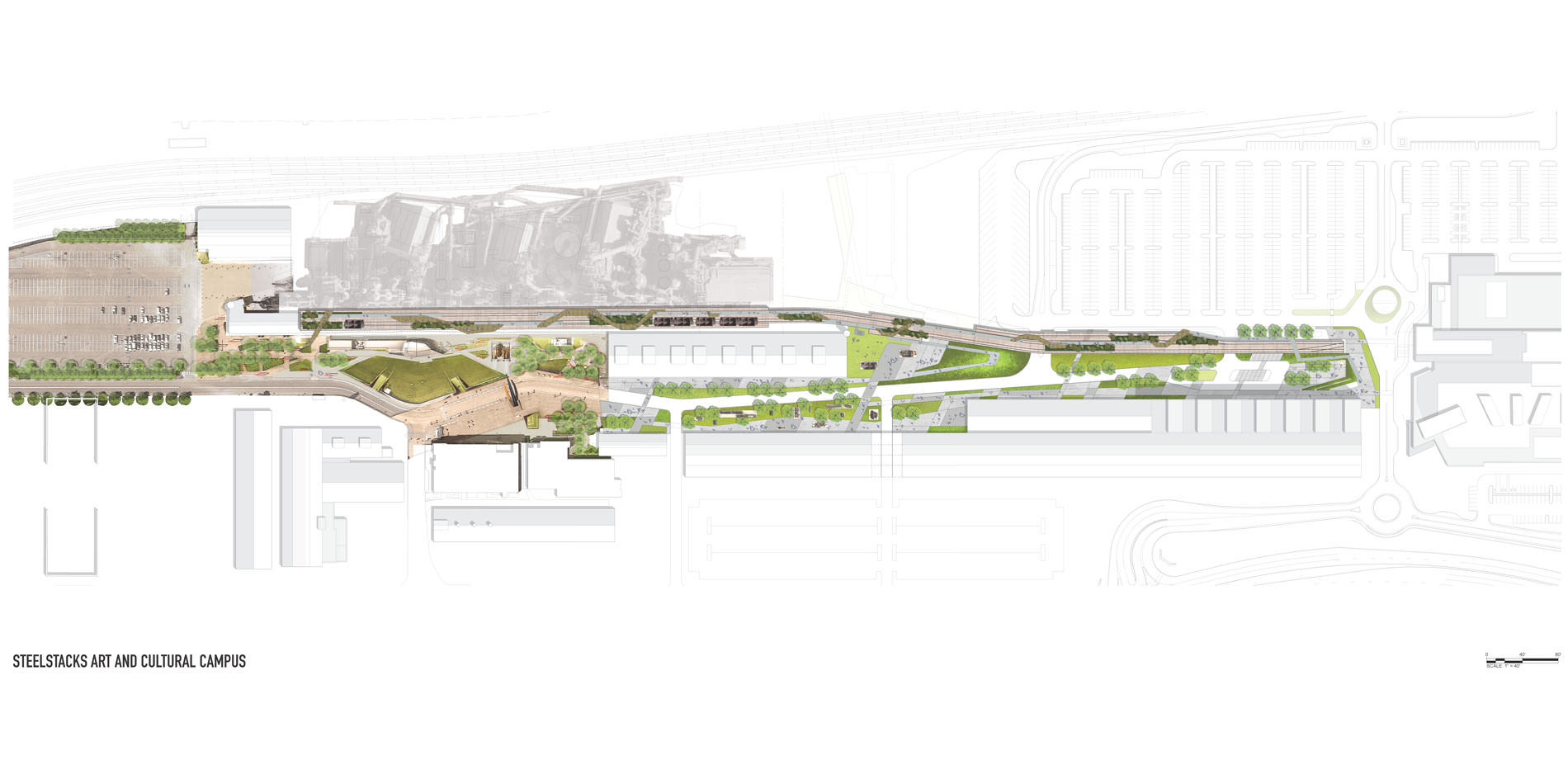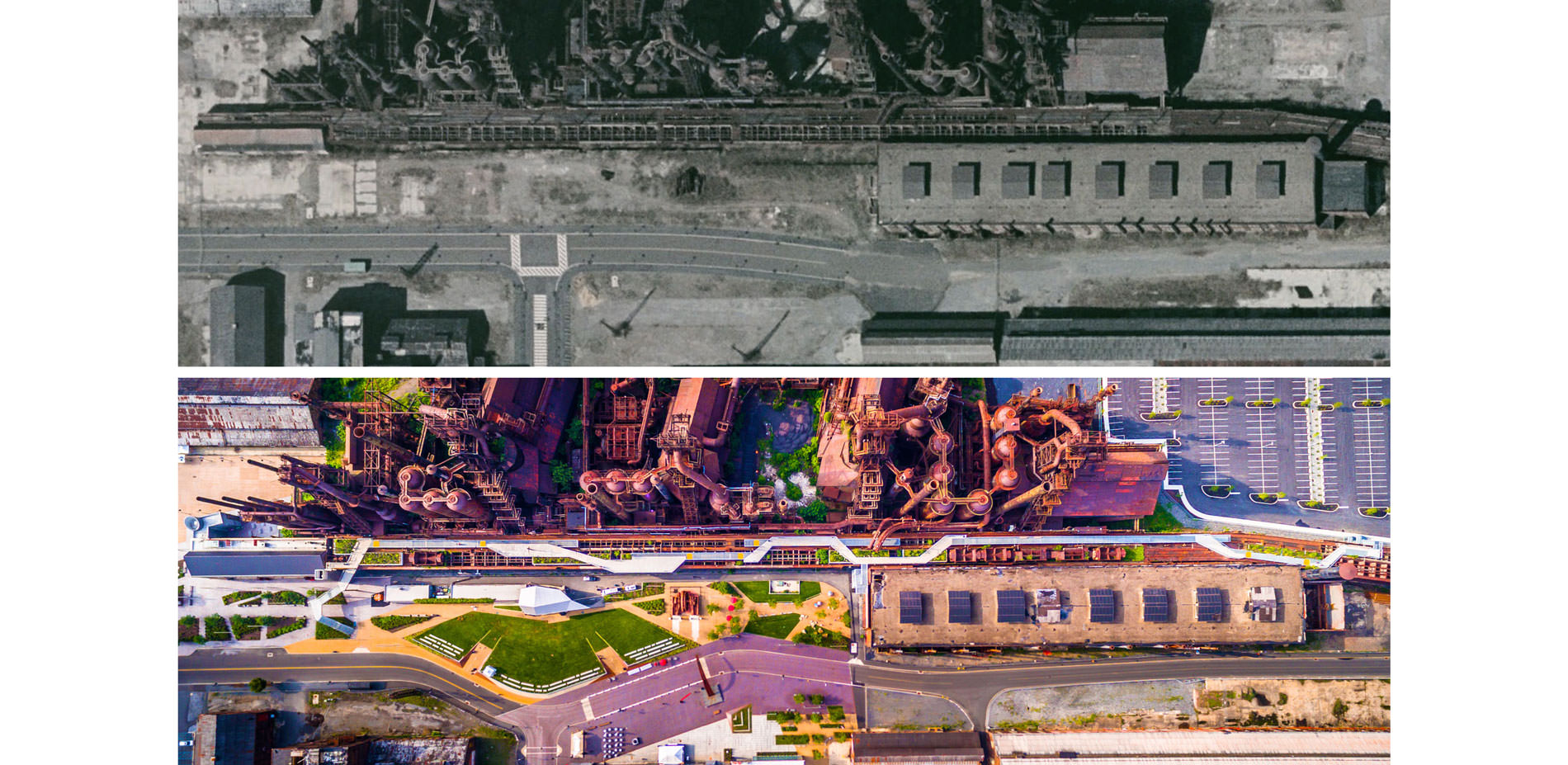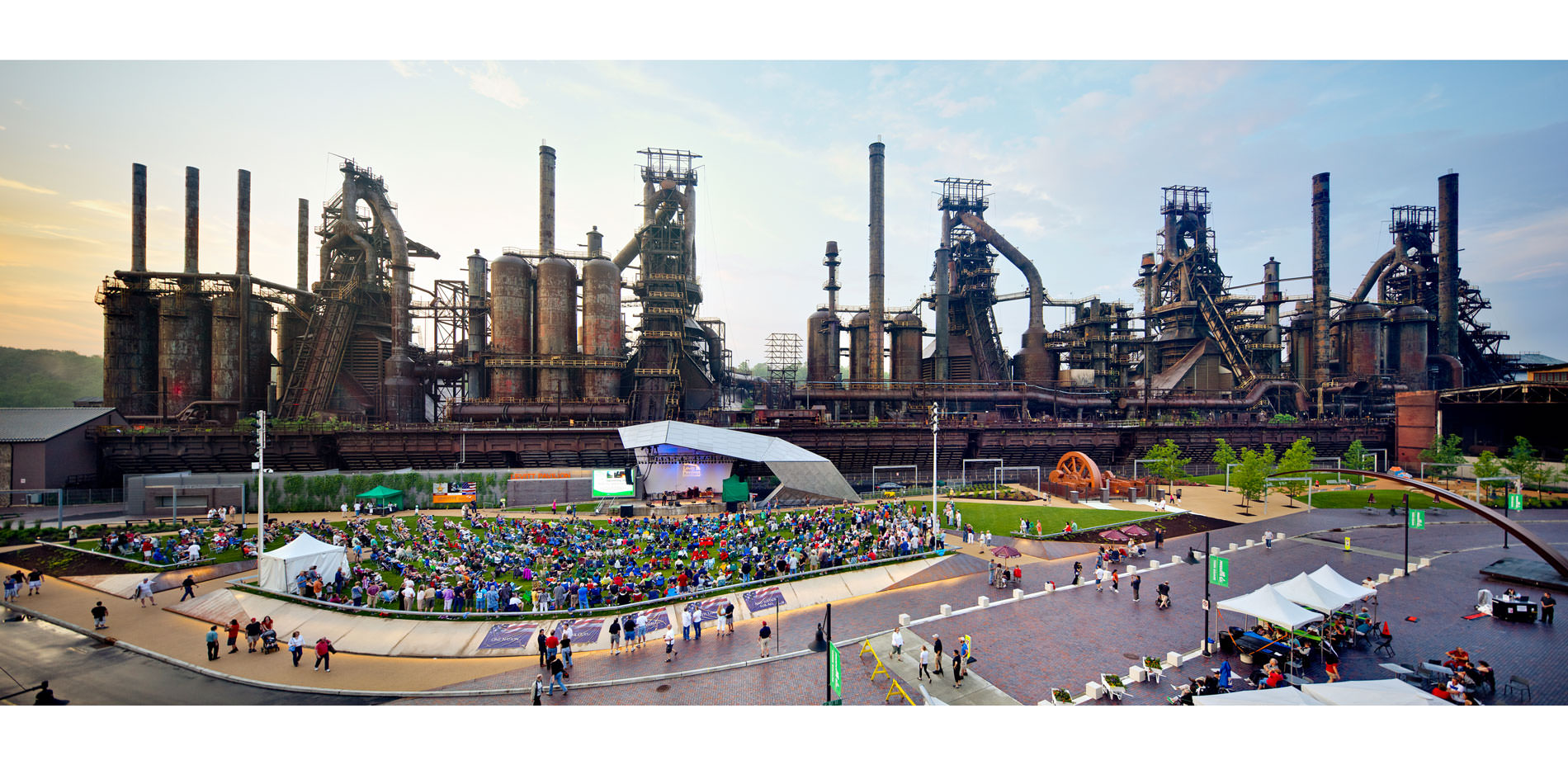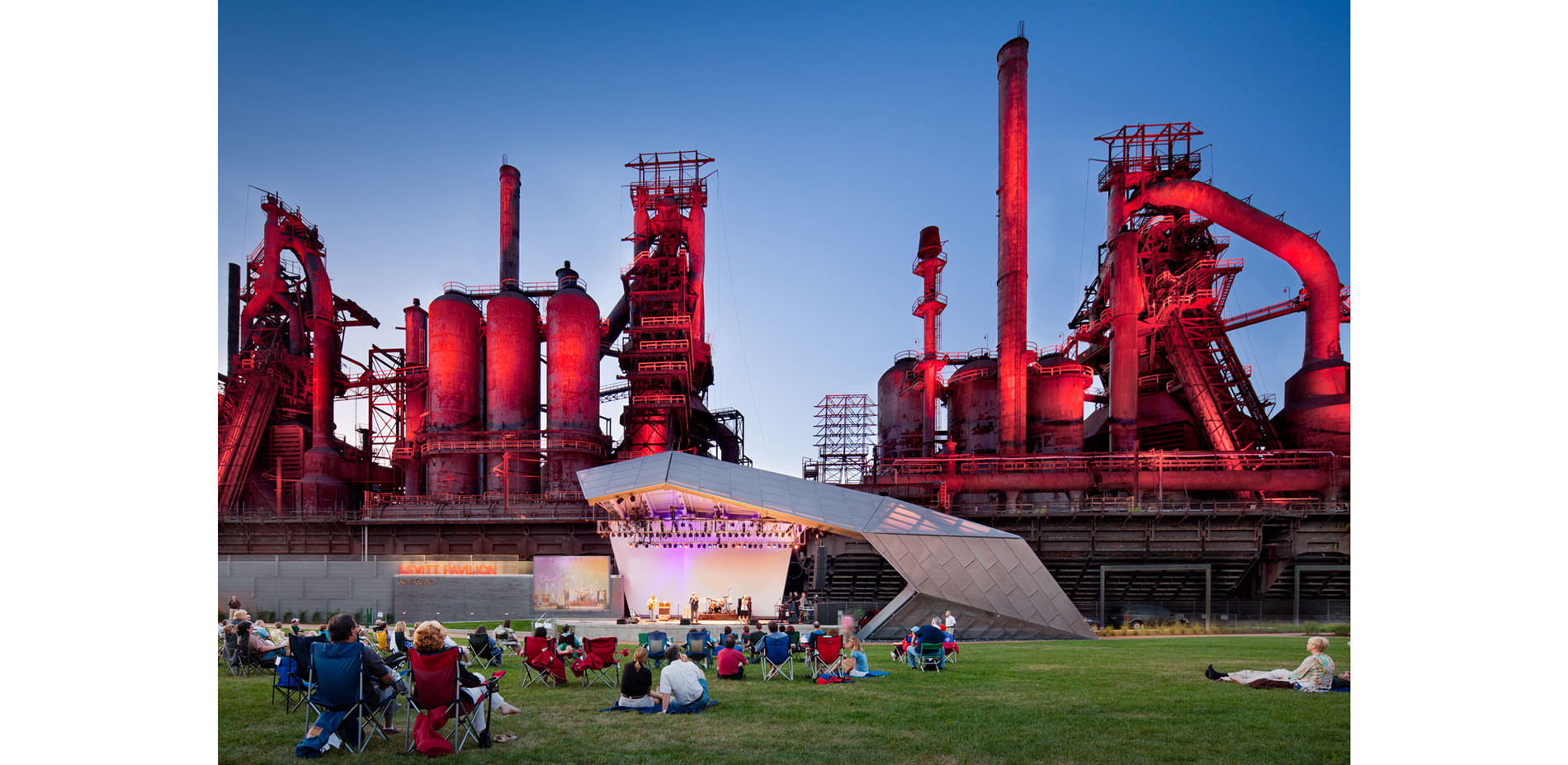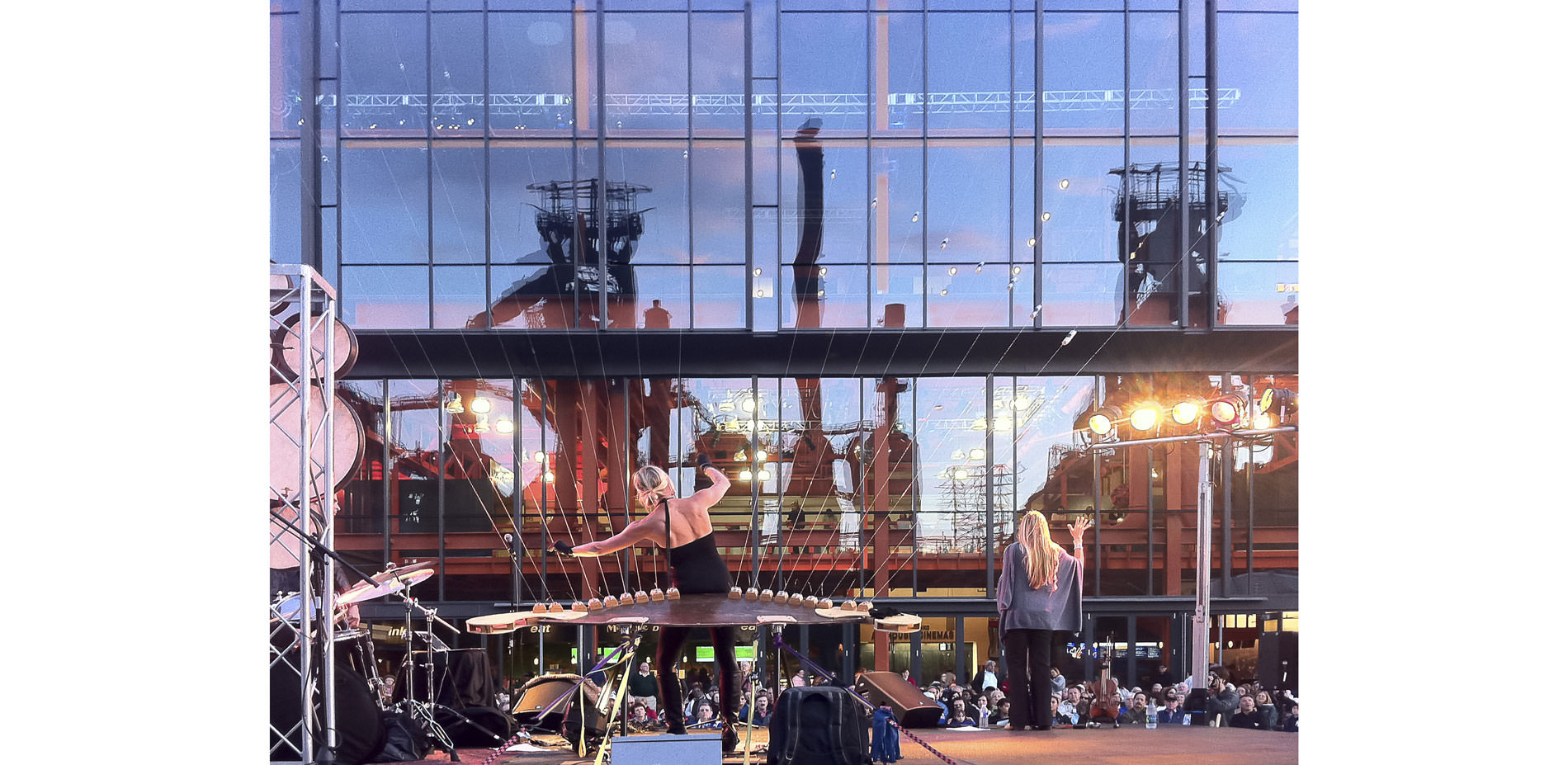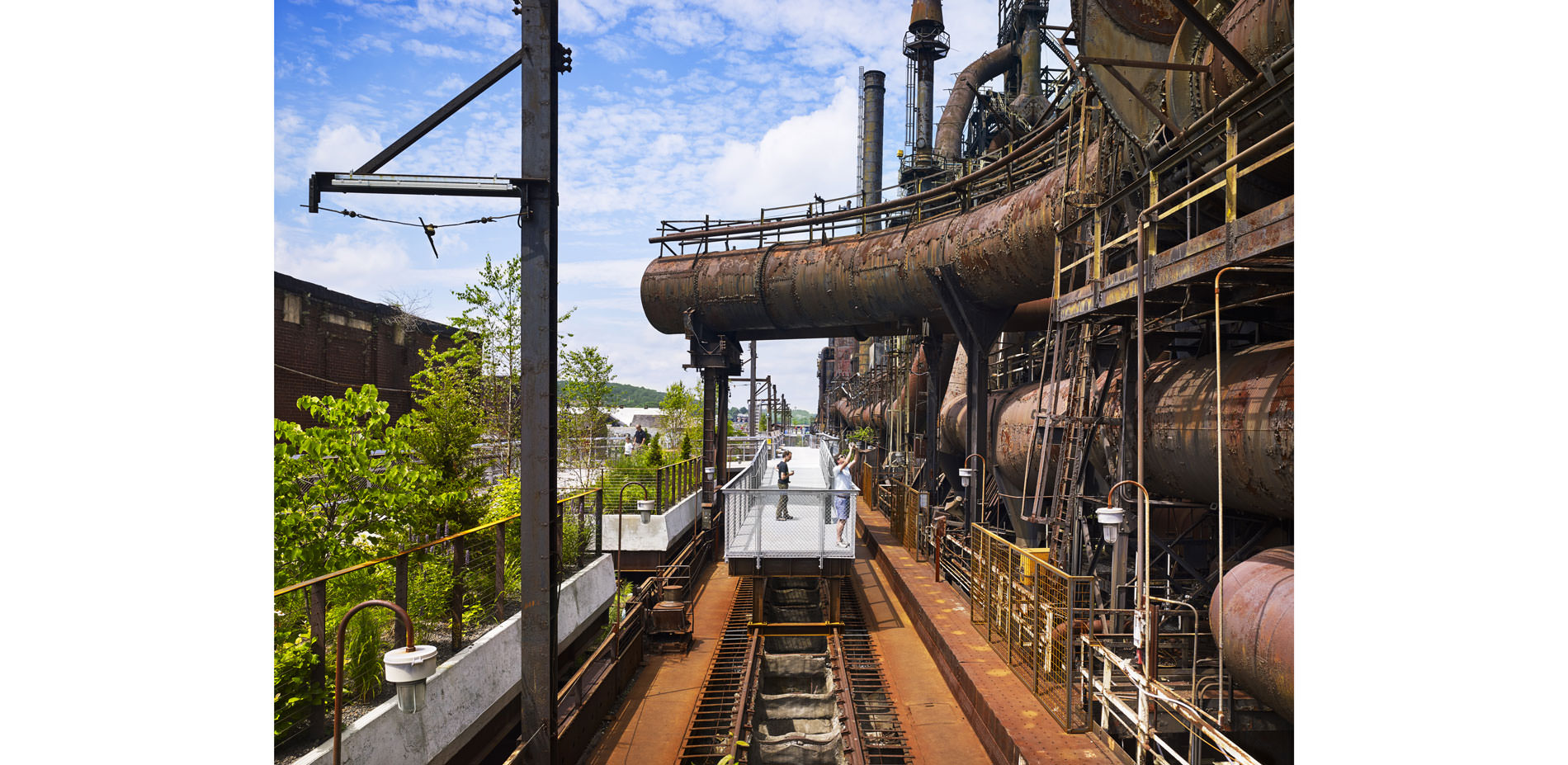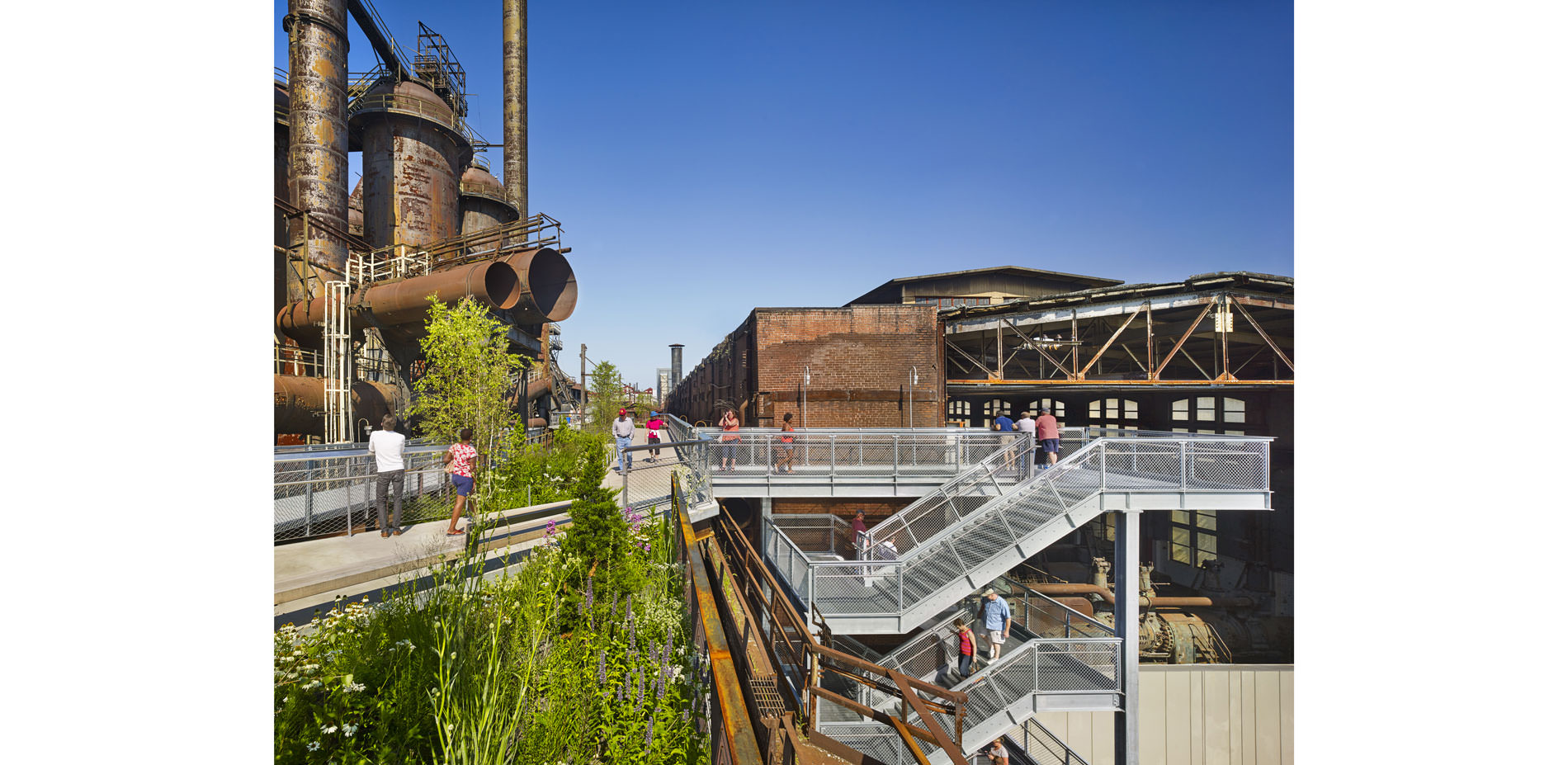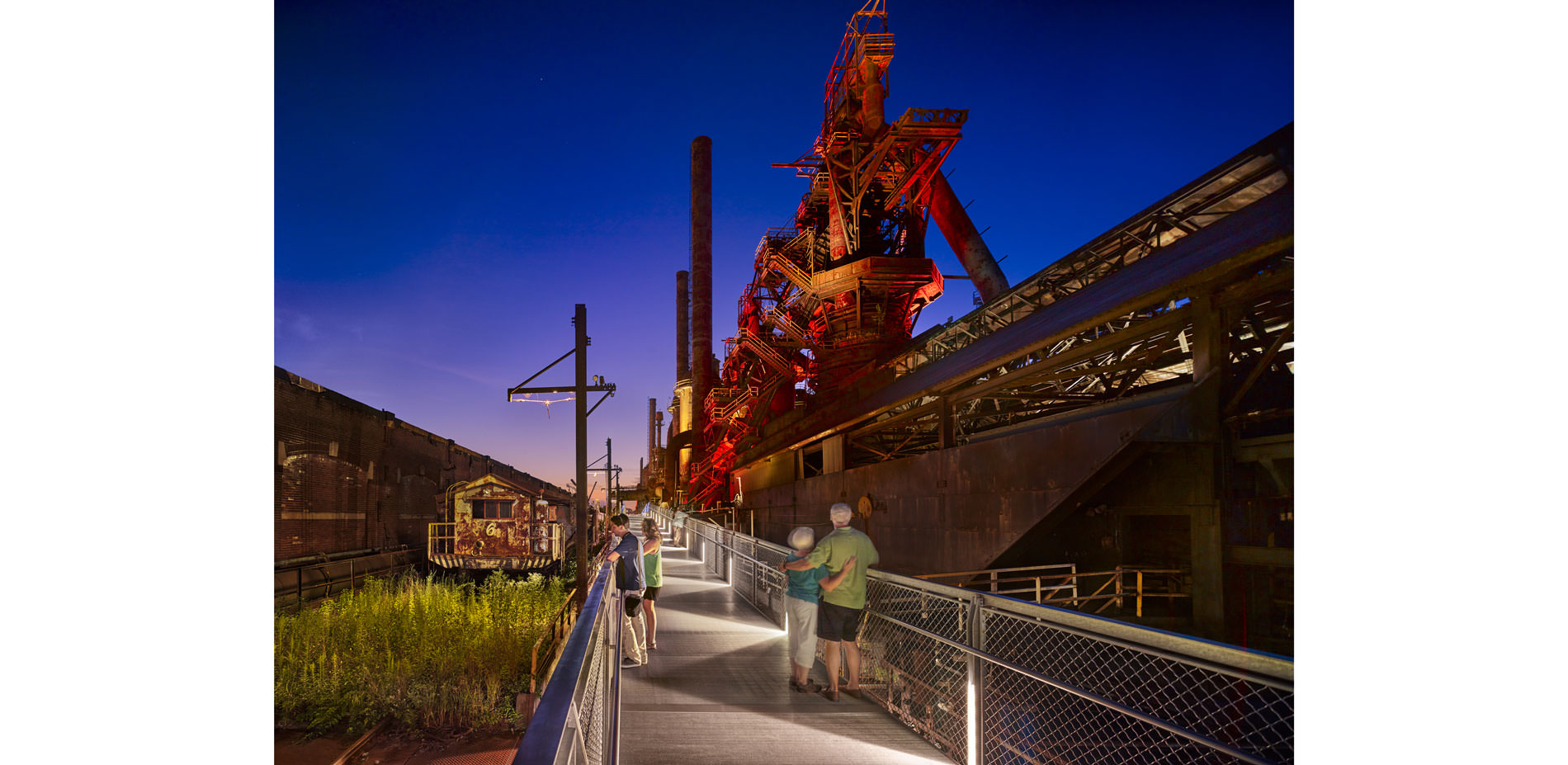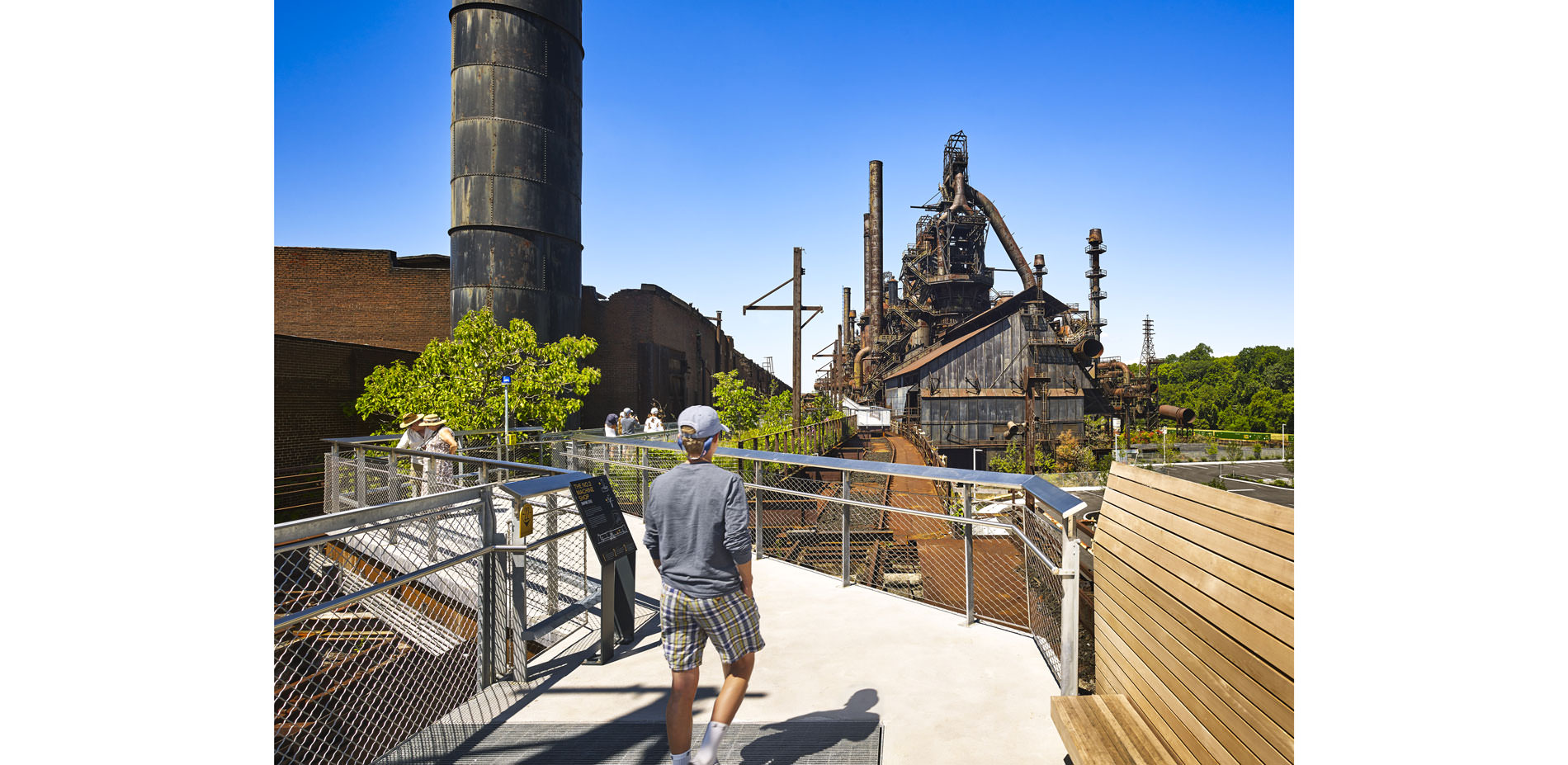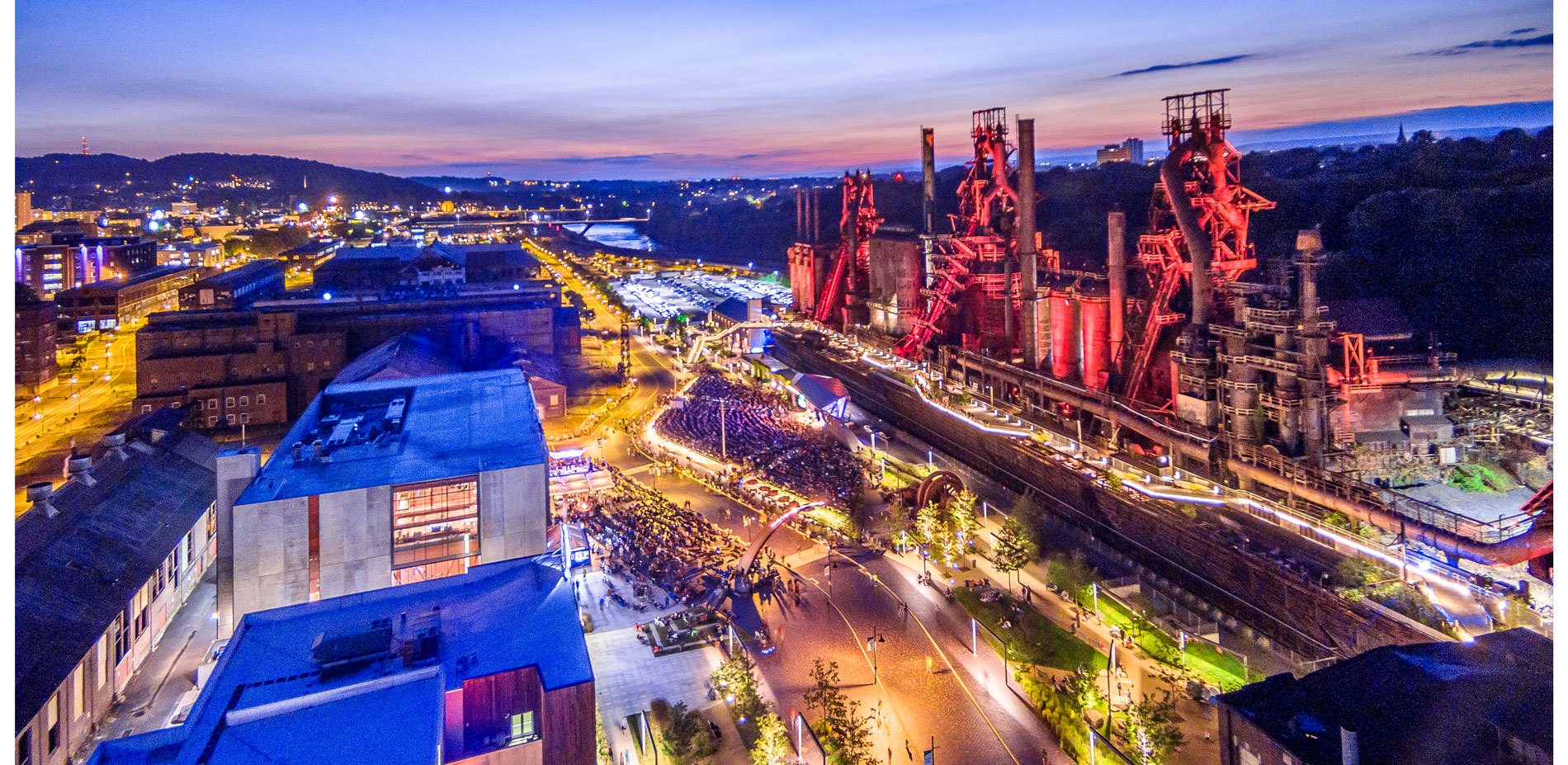SteelStacks Arts + Cultural Campus
Honor
General Design
Bethlehem, PA, USA | WRT | Client: Redevelopment Authority of the City of Bethlehem
A very successful project that fits in with the industrial past, not blowing it away but actually playing off it.
- 2017 Awards Jury
PROJECT CREDITS
Artist (Fire Sculptures)
- Elena Colombo
Acoustical
- Metropolitan Acoustics LLC
Theatrical Lighting
- Environmental Acoustics, Inc.
Construction
- Boyle Construction Inc. (HMT, Levitt Pavilion and Amphitheater, PNC Plaza)
- Alvin H. Butz, Inc. (ArtsQuest Plaza, PBS39 Plaza, Parking)
Sub-Consultants
- Preservation Architect: Artefact, Inc.
- Structural Engineering: Simpson Gumpertz & Heger [SGH]
- Structural / Survey Engineering: Maser Consulting P.A.
- Civil / Environmental Engineering: HDR Engineering
- Structural / Restoration Engineering: Klein and Hoffman, Inc.
- MEP Engineering: Lehigh Valley Engineering, Inc.
- Lighting Designer: L’Observatoire International
- Historic Interpretation Design: Local Project
- Historic Interpretation Design: Bluecadet
- Horticulture Consultant: Patrick Cullina
PROJECT STATEMENT
The SteelStacks Arts + Cultural Campus rose from the shadows of the former Bethlehem Steel Plant, invigorating the region through the transformation of an abandoned industrial site into a vibrant, urban, arts and entertainment destination. The project demonstrates the power of design to catalyze community revitalization, by paying homage to the history and integrity of the site, and allowing visitors the opportunity to once again stand at the foot of the iconic Bethlehem Steel blast furnaces. The project seamlessly knits together the reinvented steel plant site with an established neighborhood and its commercial corridor, building a heightened sense of community across the City of Bethlehem and Lehigh Valley region.
PROJECT NARRATIVE
The Bethlehem Steel Corporation was a 20th century industrial powerhouse that operated facilities around the globe. It was founded in Pennsylvania’s Lehigh Valley in 1857, occupying 1,800 acres along the Lehigh River. In 1995, the Bethlehem Steel Corporation stopped its steel-making operations in Bethlehem, closed the plant and brought to an end a long history that shaped the livelihoods, family life, and blue-collar culture of thousands of Lehigh Valley residents. In an effort to revitalize the site for future uses, the campus worked within the existing fabric of the abandoned site, while selectively transforming key site elements to offer new perspectives and experiences, creating a unique community-space for the 21st century.
The 9.5 acre SteelStacks Arts + Cultural Campus is located directly in front of the monumental blast furnaces that have dominated the Bethlehem skyline for more than a century. The Campus sits within Bethlehem Works, a 126-acre parcel that was established as a 20-year tax incremental finance district (TIF) in 2000. Bethlehem Works is part of the largest brownfield in the U.S.: the 1,800-acre former steel plant operated by Bethlehem Steel Corp, which occupies 20 percent of the City of Bethlehem’s real estate (city population: 75,000).
Over the past 10 years, the Bethlehem Redevelopment Authority oversaw the development of new industrial parks and intermodal transportation facilities on large parcels at the eastern end of the former plant. Bethlehem Works occupies the western end of the former plant, and is nestled against the city’s well-established South Side neighborhood, which includes the former plant’s oldest surviving and most historically significant structures including five 20-story-tall blast furnaces (the SteelStacks).
The Campus officially opened in July, 2011, but the scope and size of the campus is part of an ongoing transformation. Currently, three phases have been completed: 21st Century Park (2009), the Levitt Pavilion and Amphitheater, an outdoor amphitheater designed integrally with the campus (Opened 2012 – 9.5 Acres), and Phase 1 of the Hoover-Mason Trestle (Opened 2015 – 25,000sf elevated pedestrian promenade).
The Landscape Architect was the prime consultant for the design of the campus, plaza, and Levitt Pavilion grounds. In this capacity, the LA managed a multidisciplinary team of consultants including artists, lighting designers, graphic designers, engineers and soil remediation specialists. The LA also coordinated the work of an in-house architectural team working on the Levitt Pavilion structure and the Hoover-Mason Trestle, as well as architects and engineers working simultaneously on the ArtsQuest, PBS39, and Visitor Center buildings.
A key transformation was curving the roadway that traverses the campus, which created the requisite space for the 2,500-person Levitt amphitheater and its placement on axis with Founders Way, the main entry from the town. Not only does this create a unique circulation experience, but it allows the SteelStacks to serve as a powerful backdrop. The addition of the Hoover-Mason Trestle allowed visitors the ability to experience an entirely new vantage point on the site, from a promenade designed to frame and focus views outward toward items of historical and contextual importance around the campus.
While the campus is a unifying landscape, discrete areas were conceived to facilitate a diverse, flexible, and active range of programs (as of 2016, over 1.5-million visitors participate in campus events each year), including:
- An entry court facing the Visitor Center for gathering and site orientation;
- A “flex” event space adjoining the ArtsQuest building for smaller performances, outdoor dining, and overflow event space for indoor/outdoor events;
- A reading and theater space facing PBS 39 for outdoor programs
- The integration of public art to engage the community and site, funded by the National Endowment of the Arts
- A family picnic and play area facing a section of the Blower House
- The Hoover-Mason Trestle, an elevated pedestrian promenade which allows visitors to walk through the industrial archeology of the site along the same path that the raw materials to produce steel were delivered
- Interpretive signage and wayfinding devices throughout the project, including an interactive digital application to deliver audio tours, oral histories, and a database of historical images and interpretive data [hoovermason.com]
- The Levitt Pavilion amphitheater as the campus centerpiece, which organizes 50 free family-friendly concerts each summer, and also functions as a community playfield during non-events
The overriding design intent was to create an extraordinary setting capturing the stunning scale and mass of the SteelStacks as a backdrop for year-round festivals, art events, and music performances. Of paramount importance was the transformation of the site from daytime to evening and nighttime experiences, creating a welcoming public center that draws families and individuals, locally and regionally.
Much like this area of the site worked as a component of the much larger Bethlehem Steel plant, the repurposed campus serves to enhance the site and the community of Bethlehem, by preserving the history and integrity of the site, and allowing visitors [including an entire legacy of former Bethlehem Steel workers and their families] the opportunity to once again inhabit the site, and stand at the foot of the iconic Bethlehem SteelStacks.
In consideration of summer weather, shade trees were located by the entry court, picnic and play areas of the plaza, allowing the SteelStacks to remain in full view from the main gathering and performance areas. Self-rusting weathering steel, galvanized steel, dark pavers, granite, concrete and molten-like bonded aggregate define the material palette at the ground plane in an effort to evoke the tough and rugged spirit of the place.
The Hoover-Mason Trestle structure was designed to tread-lightly over the existing structure. All new surfaces and planters are supported by a new steel structure that attaches at the location of the existing rail tracks, and the new structural steel was designed in weathering steel to blend with the existing SteelStacks, and allow the walkways to visually float above the structure, as a clearly identifiable new structure, juxtaposing new and old. Respecting the linearity of the rail tracks, metal-grating walkways run parallel immediately above the tracks, encouraging people to look down and acknowledge the existing site.
The site offered many environmental challenges, due to the presence of soils that could not be disturbed or penetrated, except in isolated cases. Large areas of existing building foundations were removed, exchanging impervious cover for pervious, and minimizing the generation of storm runoff. Plantings were brought to the site where none existed beforehand, increasing the site’s biomass, and a low level of illumination was accepted as a way to minimize energy consumption. Socially, the project has engaged the local community, offering a “town green” for future uses that will bring new urban life to the heart of Bethlehem in support of regional smart growth initiatives. The project’s success is contributing to the sustainability of the campus’s tenants, spurring private development in abandoned buildings and sites adjacent to the campus, while also bolstering existing businesses in the surrounding neighborhood.
The design brings a tremendous positive impact to the site, most importantly revitalizing an abandoned site in a way that both educates and creates a sense of community for both local inhabitants, and visitors. The campus serves as a forecourt for the Bethlehem Visitor Center, and has enabled its nonprofit partners (PBS39 - , the Lehigh Valley’s public television studio; and ArtsQuest - an institution providing year-round art education and performances) to expand their public programs, which has strengthened these organizations. They now work with newly established campus nonprofits (including Friends of Levitt Pavilion SteelStacks, and Penn State Master Gardeners) and Discover Lehigh Valley to provide landscape maintenance, funding, and support services to visitors. Their combined success, along with an ongoing commitment from the city, ensures that this redevelopment project is not only innovative but also sustainable in terms of its environmental impact.
PRODUCTS
Product Sources: FURNITURE
- Landscape Forms (Custom Bench), Erlau Site Furnishing
Product Sources: DRAINAGE/EROSION
- 2B Stone Drainage (AASHTO #57) : Valley Stone Quarry
Product Sources: FENCES/GATES/WALLS
- Levan Associate (Custom Fence, guardrail, stairs), Decorative Railing : Carlstahl (Stainless mesh)
Product Sources: IRRIGATION
Product Sources: LUMBER/DECKING/EDGING
- Galvanized steel edge, Galvanized steel composite deck with C.I.P Concrete, Galvanized Bar Grating Deck
Product Sources: PARKS/RECREATION EQUIPMENT
- Play Equipment: Kompan, BLOQX, Speeder, Junior Spica, Spinner Bowl, Daisy
Product Sources: STRUCTURES
- All Structures are design by WTR + SGH, and fabricated by Levan Associate
Product Sources: SOILS
- Top Soil: Green Valley Landscape, Inc.
Product Sources: HARDSCAPE
- Brick Unit Paving: Endicott Clay Products, Concrete Pavers: Hannover Architectural Products, Playground Surfacing : Surface America, Inc.
Product Sources: LIGHTING
